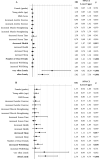A large sample cross-sectional study on mental health challenges among adolescents and young adults during the COVID-19 pandemic at-risk group for loneliness and hopelessness during the COVID-19 pandemic
- PMID: 36681303
- PMCID: PMC9847220
- DOI: 10.1016/j.jad.2023.01.067
A large sample cross-sectional study on mental health challenges among adolescents and young adults during the COVID-19 pandemic at-risk group for loneliness and hopelessness during the COVID-19 pandemic
Abstract
Background: The COVID-19 pandemic has posed unprecedented challenges for societies. Emerging data have indicated that the younger population are the most vulnerable group to the development of mental health problems during this pandemic. The present study aimed to examine the effects of the changes in health behaviors on mental health problems to identify an at-risk group among adolescents and young adults.
Methods: In the present cross-sectional study, secondary school students (N = 2556) ages 15-21 years participated in Hungary. A self-report questionnaire was developed to measure the changes in health behaviors. Mental health problems were measured by the Beck Hopelessness Scale and the 20-item UCLA Loneliness Scale.
Results: A significant proportion of the students showed moderate/severe hopelessness or high loneliness which were more pronounced among adolescent females. An at-risk group was identified among adolescents and young adults. Students who have a lower number of friends, spend less time in front of a screen, and feel lonely often/very often are more likely to have moderate/severe hopelessness with high loneliness.
Limitations: All data were collected online, and students completed the questionnaires voluntarily. Cross-sectional, non-preregistered study.
Conclusions: Loneliness and hopelessness were prevalent in the young population during the COVID-19 pandemic. The at-risk group of adolescents characterized by moderate/severe hopelessness with high loneliness highlights the need for follow-up mental health to avoid future poor mental and physical health. It is also recommended to develop effective interventions targeted to gender and age, with the promotion of resiliencies and buffers against vulnerabilities of negative life events.
Keywords: Adolescents; COVID-19 pandemic; Hopelessness; Loneliness; Risk group; Young adults.
Copyright © 2023 The Authors. Published by Elsevier B.V. All rights reserved.
Conflict of interest statement
Conflict of interest The authors have declared that they have no competing or potential conflicts of interest.
Figures


Similar articles
-
Impact of COVID-19 pandemic on mental health among general Bangladeshi population: a cross-sectional study.BMJ Open. 2021 Apr 9;11(4):e045727. doi: 10.1136/bmjopen-2020-045727. BMJ Open. 2021. PMID: 33837107 Free PMC article.
-
Loneliness among adolescents and young adults with cancer during the COVID-19 pandemic: a cross-sectional survey.Support Care Cancer. 2022 Mar;30(3):2215-2224. doi: 10.1007/s00520-021-06628-5. Epub 2021 Oct 27. Support Care Cancer. 2022. PMID: 34708310 Free PMC article.
-
Feelings of loneliness and mental health needs and services utilization among Chinese residents during the COVID-19 epidemic.Global Health. 2021 Apr 26;17(1):51. doi: 10.1186/s12992-021-00704-5. Global Health. 2021. PMID: 33902638 Free PMC article.
-
Rapid Systematic Review: The Impact of Social Isolation and Loneliness on the Mental Health of Children and Adolescents in the Context of COVID-19.J Am Acad Child Adolesc Psychiatry. 2020 Nov;59(11):1218-1239.e3. doi: 10.1016/j.jaac.2020.05.009. Epub 2020 Jun 3. J Am Acad Child Adolesc Psychiatry. 2020. PMID: 32504808 Free PMC article.
-
A systematic review of the mental health changes of children and young people before and during the COVID-19 pandemic.Eur Child Adolesc Psychiatry. 2023 Jun;32(6):995-1013. doi: 10.1007/s00787-022-02060-0. Epub 2022 Aug 12. Eur Child Adolesc Psychiatry. 2023. PMID: 35962147 Free PMC article.
Cited by
-
Psychosocial work environment stressors for school staff during the COVID-19 pandemic: Barriers and facilitators for supporting wellbeing.Front Public Health. 2023 Mar 13;11:1096240. doi: 10.3389/fpubh.2023.1096240. eCollection 2023. Front Public Health. 2023. PMID: 36992895 Free PMC article.
-
COVID-19 and social distancing: pandemic has altered social relationships and contacts in older adults over 4 years.Front Public Health. 2024 Dec 16;12:1456829. doi: 10.3389/fpubh.2024.1456829. eCollection 2024. Front Public Health. 2024. PMID: 39737450 Free PMC article.
-
Network structure of emotional and behavioral problems, loneliness, and suicidal thoughts in adolescents at the school closure and reopening stage in China.Transl Pediatr. 2023 Jul 31;12(7):1373-1385. doi: 10.21037/tp-23-33. Epub 2023 Jul 19. Transl Pediatr. 2023. PMID: 37575901 Free PMC article.
References
-
- Abramson L.Y., Metalsky G.I., Alloy L.B. Hopelessness depression: a theory-based subtype of depression. Psychol. Rev. 1989;96:358–372. doi: 10.1037/0033-295X.96.2.358. - DOI
-
- Beck A.T., Steer R.A. Psychological Corp; San Antonio, TX: 1988. Manual for the Beck Hopelessness Scale.
-
- Beutel M.E., Klein E.M., Brähler E., Reiner I., Jünger C., Michal M., Wiltink J., Wild P.S., Münzel T., Lackner K.J., Tibubos A.N. Loneliness in the general population: prevalence, determinants and relations to mental health. BMC Psychiatry. 2017;17:97. doi: 10.1186/s12888-017-1262-x. - DOI - PMC - PubMed
MeSH terms
LinkOut - more resources
Full Text Sources
Medical

